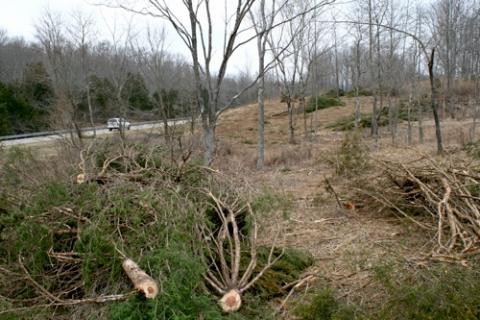The next time you visit Mammoth Cave National Park, take a look at the landscape just inside the Park City entrance. While it might look unkempt in the near term, down the road it will take on its natural appearance as a "barren," or prairie reminiscent of what originally existed.
The revegetation project is just the latest by park crews, who during the past decade have been paying just as much attention to what's above ground at the park as to what's underground. So far crews have restored four barrens at Wondering Woods, Great Onyx Job Corps, and on Flint Ridge. The current work along the Mammoth Cave Parkway near Park City is in an awkward stage of change and growth.
“I compare our progress on this new barren to adolescence,” said Superintendent Patrick Reed. “We are cutting trees to expose the ground to sunlight and the area looks a bit rough right now. We expect seed stock in the ground will sprout in the spring and summer. Please bear with us through these growing pains – it will be beautiful in another year or so.”
The project actually began back in November 2008, when cedars and pines were removed from about 71 acres on either side of the parkway. Now other trees and exotics are being cut to open the canopy and allow sunlight to reach the ground, say park officials. The sunlight will allow dormant seeds left by prairie plants years ago to germinate.
“Unlike the other prairie sites in the park, which were planted, this time we are allowing previous grassland to restore itself,” said Rick Olson, park ecologist. “In 2009, we saw many prairie species pop up on their own – native sunflowers, butterfly milkweed, lobelia, asters, and tall coreopsis.”
At the other sites, woody and exotic species were removed with heavy equipment and herbicides, and then planted in prairie grasses and flowering plants.
“The edge – where forest and open areas meet – is important to many birds and mammals,” said Mr. Olson. “The barrens, for which Barren County is named, once covered hundreds of thousands of acres out on the Sinkhole Plain. Restoring these karst grasslands will help provide habitat for many wildflower species that simply have almost no place to grow.”
While the work progresses, portions of Mammoth Cave RR Bike & Hike trail will be temporarily closed between the park boundary at Park City and the top of the hill at Chaumont.
“For safety, we are asking the public to use other sections of the trail while this work in under way,” said Superintendent Reed.




Add comment